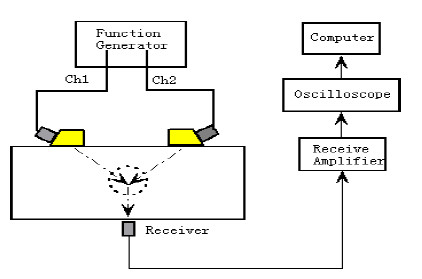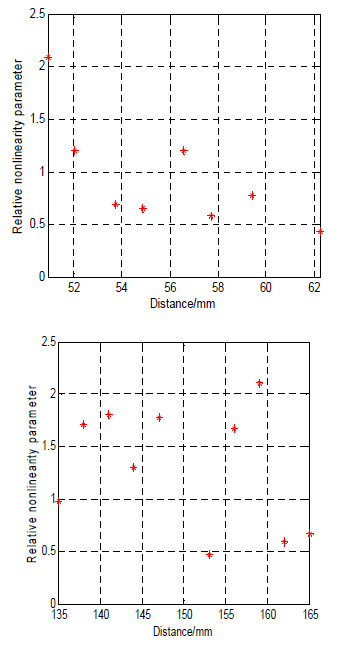Keywords: Non-collinear mixing method; Nonlinearity parameter; The plastic zone
The existence and propagation of cracks in solid materials are fatal for mechanical performances. Critical stress is related length of crack and range of plastic zone at crack tip. When stress loaded on the crack is more than critical stress, the crack will happen to expand fast, leading to the material fracture. So detection of plastic zone at crack tip is helpful to obtain the crack propagation rate.
By non-collinear mixing method, a nonlinearity parameter is utilized to evaluate plastic zone at crack tip. A schematic of the proposed non-collinear mixing method of the ultrasonic measurement system is shown in Fig.1. Researchers from the Institute of Acoustics of the Chinese Academy of Sciences have demonstrated feasibility of the non-collinear mixing method by measuring range of plastic zone at crack tip.
Two longitudinal wave signals of 15 cycles at 2.2MHz are generated by a function generator (Ritec RAM-5000SNAP). In order to ensure two signals interact, the number of cycles of the signals is not too small. And the arrival time of two ultrasonic waves must be almost the same, so computer should have a precise delay system. The new generated signal will be received by a longitudinal transducer at the other side of the aluminum block.

Fig. 1. Experimental setup (Image by LI)
With changing the wave interaction region, spatial distribution of nonlinearity parameter around crack tip is measured. According to experimental result, plastic deformation around crack tip on the specimens range is less than 52mm in longitudinal direction, between 144mm and 156mm in transverse direction. As a result, a conclusion is made that the plastic zone at crack tip, which is about less than 3mm in longitudinal direction and less than 8mm in transverse direction, can be measured by the non-collinear mixing method. This research reveals potential application of ultrasonic nondestructive to evaluate mechanical properties.

Fig. 2. Experimental results (Image by LI)
References:
LI Haiyang, AN Zhiwu, LIAN Guoxuan, WANG Xiaomin. Detection of Plastic Zone at Crack Tip by Non-collinear Mixing Method. Piezoelectricity, Acoustic Waves, and Device Applications (SPAWDA), 2014 Symposium on, ISBN 978-1-4799-6424-6, IEEE (pp. 154 - 157, Oct. 30 2014-Nov. 2, 2014, Beijing, China). DOI: 10.1109/SPAWDA.2014.6998549
Contact:
Li Haiyang
State Key Laboratory of Acoustics, Institute of Acoustics, Chinese Academy of Sciences, 100190 Beijing, China
E-mail: climb_021@163.com


